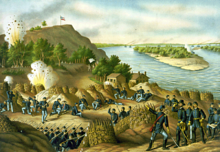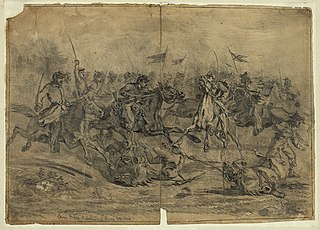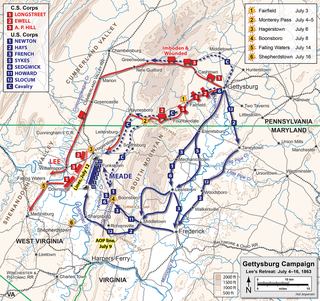| Date | Engagement | Military units | Losses |
|---|
| January 1 | Galveston II, Texas | Confederate District of Texas, Union garrison | Confederate 50, Union 600 [8] |
| January 8 | Springfield II, Missouri | Confederate cavalry from District of Arkansas, Union garrison | Confederate 240, Union 163 [9] |
| January 9–10 | Arkansas Post, Arkansas | Confederate Army of the Lower Arkansas and White Rivers, Union Army of the Mississippi and Mississippi Squadron | Confederate 5,004, Union 1,092 [10] |
| January 9–11 | Hartville, Missouri | Confederate cavalry, Union garrison | Confederate 329, Union 78 [11] |
| January 27 – March 3 | Battle of Fort McAllister (1863), Georgia | Confederate garrison, Union squadron from South Atlantic Blockading Squadron | Confederate one, Union none [12] |
| January 29 | Bear River, Idaho | Union infantry, Shoshoni tribe | Union 64, Shoshoni 250 [13] |
| February 3 | Dover, Tennessee | Confederate cavalry from Army of Tennessee, Union garrison | Confederate 855, Union 110 [14] |
| March 4–5 | Thompson's Station, Tennessee | Confederate cavalry, Union infantry | Confederate 357, Union 1,600 [15] |
| March 13–15 | Fort Anderson, North Carolina | Confederate Department of North Carolina, Union garrison | 7 total [16] |
| March 17 | Kelly's Ford, Virginia | Cavalry from Confederate Army of Northern Virginia and Union Army of the Potomac | Confederate 80, Union 99 [17] |
| March 20 | Vaught's Hill, Tennessee | Confederate and Union cavalry | Confederate 150, Union 38 [18] |
| March 25 | Brentwood, Tennessee | Confederate cavalry division, Union garrison | Confederate 3, Union 529 [19] |
| March 30 – April 20 | Washington, North Carolina | Confederate Department of North Carolina, Union garrison | 100 total [20] |
| April 7 | Charleston Harbor I, South Carolina | Confederate garrison of Fort Sumter, Union South Atlantic Blockading Squadron | Confederate 14, Union 22 [21] |
| April 10 | Franklin I, Tennessee | Confederate and Union cavalry | Confederate 137, Union 100 [22] |
| April 12–13 | Fort Bisland, Louisiana | Confederate District of West Louisiana, Union XIX Corps | Confederate 450, Union 224 [23] |
| April 13–15 | Suffolk I, Virginia | Confederate First Corps, Army of Northern Virginia, Union Department of Virginia | unknown [24] |
| April 14 | Irish Bend, Louisiana | Confederate District of West Louisiana, Union division from XIX Corps | Confederate unknown, Union 353 [25] |
| April 17 | Vermilion Bayou, Louisiana | Confederate District of West Louisiana, Union XIX Corps | unknown [26] |
| April 19 | Suffolk II, Virginia | Confederate First Corps, Army of Northern Virginia, Union Department of Virginia | unknown [27] |
| April 26 | Cape Girardeau, Missouri | Confederate cavalry, Union garrison | Confederate 325, Union 12 [28] |
| April 29 | Grand Gulf, Mississippi | Confederate batteries from Army of Vicksburg, Union Mississippi squadron | Confederate unknown, Union 80 [29] |
| April 29 | Snyder's Bluff, Mississippi | Confederate artillery, Union Mississippi squadron | unknown [30] |
| April 30 | Day's Gap, Alabama | Confederate and Union cavalry | Confederate 65, Union 23 [31] |
| May 1 | Port Gibson, Mississippi | Confederate Army of Vicksburg, Union Army of the Tennessee | Confederate 787, Union 875 [32] |
| May 1–2 | Chalk Bluff, Arkansas | Confederate cavalry, Union infantry | fewer than 100 [28] |
| May 1–6 | Chancellorsville, Virginia | Confederate Army of Northern Virginia, Union Army of the Potomac | Confederate 13,460, Union 17,304 [33] |
| May 3 | Fredericksburg II, Virginia | Confederate division from Second Corps, Army of Northern Virginia, Union VI Corps and division from II Corps, Army of the Potomac | Confederate 475, Union 1,100 [34] |
| May 3–4 | Salem Church, Virginia | Confederate Army of Northern Virginia, Union VI Corps and division from II Corps, Army of the Potomac | Confederate 674, Union 1,523 [35] |
| May 12 | Raymond, Mississippi | Confederate Army of Vicksburg, Union Army of the Tennessee | Confederate 442, Union 514 [36] |
| May 14 | Jackson, Mississippi | Confederate garrison, Union Army of the Tennessee | Confederate 850, Union 286 [37] |
| May 16 | Champion Hill, Mississippi | Confederate Army of Vicksburg, Union Army of the Tennessee | Confederate 3,840, Union 2,441 [38] |
| May 17 | Big Black River Bridge, Mississippi | Confederate Army of Vicksburg, Union Army of the Tennessee | Confederate 1,741, Union 276 [39] |
| May 18 – July 4 | Vicksburg, Mississippi | Confederate Army of Vicksburg, Union Army of the Tennessee | Confederate 32,697 (29,495 surrendered), Union 4,835 [40] |
| May 21 | Plains Store, Louisiana | Confederate Department of Mississippi, Union Department of the Gulf | Confederate 100, Union 150 [41] |
| May 22 – July 9 | Port Hudson, Louisiana | Confederate garrison, Union Department of the Gulf | Confederate 7,500, Union 10,000 [42] |
| June 7 | Milliken's Bend, Louisiana | Confederate division, Union garrison | Confederate 185, Union 652 [43] |
| June 9 | Brandy Station, Virginia | Cavalry corps from Army of Northern Virginia, Union Army of the Potomac | Confederate 515, Union 866 [44] |
| June 13–15 | Winchester II, Virginia | Confederate Second Corps, Army of Northern Virginia, Union garrison from Middle Department | Confederate 269, Union 4,443 [45] |
| June 17 | Aldie, Virginia | Cavalry from Confederate Army of Northern Virginia and Union Army of the Potomac | Confederate 119, Union 300 [46] |
| June 19 | Middleburg, Virginia | Cavalry from Confederate Army of Northern Virginia and Union Army of the Potomac | unknown [47] |
| June 19 | Ashby's Gap, Virginia | Cavalry from Confederate Army of Northern Virginia and Union Army of the Potomac | unknown [48] |
| June 20–21 | LaFourche Crossing, Louisiana | Confederate District of West Louisiana, Union garrison | Confederate 219, Union 49 [49] |
| June 21 | Upperville, Virginia | Cavalry from Confederate Army of Northern Virginia and Union Army of the Potomac | unknown [50] |
| June 24–26 | Hoover's Gap, Tennessee | Confederate Army of Tennessee, Union Army of the Cumberland | Confederate unknown, Union 583 [51] |
| June 28 | Donaldsonville II, Louisiana | Confederate District of West Louisiana, Union garrison | Confederate 301, Union 23 [52] |
| June 28 | Near Fort Rice, North Dakota | Party of Sioux Indians, Union Department of the Northwest | Sioux three, Union one [53] |
| June 29 | Oyster's Point (Camp Hill), Pennsylvania | Confederate cavalry brigade, Army of Northern Virginia, Union Department of the Susquehanna | Confederate none, Union one wounded [54] |
| June 29–30 | Goodrich's Landing, Louisiana | Confederate cavalry, Union garrison | Confederate 6, Union 150 [55] |
| June 30 | Hanover, Pennsylvania | Cavalry from Confederate Army of Northern Virginia and Union Army of the Potomac | Confederate 150, Union 200 [56] |
| June 30 | Sporting Hill, Pennsylvania | Confederate cavalry brigade, Army of Northern Virginia, Union Department of the Susquehanna | Confederate 35–45, Union unknown [57] |
| July 1–3 | Gettysburg, Pennsylvania | Confederate Army of Northern Virginia, Union Army of the Potomac | Confederate 22,625, Union 22,813 [58] |
| July 1–2 | Cabin Creek, Oklahoma | Confederate Cherokees and Texas cavalry, Union infantry | Confederate 59, Union 21 [59] |
| July 1 | Hunterstown, Pennsylvania | Cavalry from Confederate Army of Northern Virginia and Union Army of the Potomac | unknown [60] |
| July 3 | Fairfield, Pennsylvania | Confederate cavalry brigade, Army of Northern Virginia, Union 6th U.S. Cavalry Regiment | Confederate 44, Union 242 [61] |
| July 4 | Helena, Arkansas | Confederate District of Arkansas, Union garrison | Confederate 1,636, Union 239 [62] |
| July 6 | Williamsport, Maryland | Cavalry from Confederate Army of Northern Virginia and Union Army of the Potomac | Confederate 254, Union 400 [63] |
| July 7 | Funkstown, Maryland | Cavalry from Confederate Army of Northern Virginia and Union Army of the Potomac | unknown [64] |
| July 8 | Boonsboro, Maryland | Cavalry from Confederate Army of Northern Virginia and Union Army of the Potomac | 100 total [65] |
| July 9 | Corydon, Indiana | Confederate cavalry, Union militia | Confederate 51, Union 360 [66] |
| July 10 | Funkstown, Maryland | Cavalry from Confederate Army of Northern Virginia and Union Army of the Potomac | 479 total [67] |
| July 10–11 | Fort Wagner I, South Carolina | Confederate garrison of Fort Wagner, Union Department of the South | Confederate 12, Union 339 [68] |
| July 12 | Jackson, Mississippi | Confederate Department of the West, Union Army of the Tennessee | Confederate 50, Union 510 [69] |
| July 12–13 | Kock's Plantation, Louisiana | Confederate District of West Louisiana, Union Department of the Gulf | Confederate 33, Union 465 [70] |
| July 14 | Hoke's Run or Falling Waters, Maryland | Confederate division from Army of Northern Virginia, Union cavalry from Army of the Potomac | unknown [71] |
| July 16 | Grimball's Landing, South Carolina | Confederate Department of South Carolina, Georgia, and Florida, Union Department of the South | Confederate 18, Union 46 [72] |
| July 17 | Honey Springs, Oklahoma | Confederate division from Trans-Mississippi Department, Union Army of the Border | Confederate 134, Union 77 [73] |
| July 18 | Fort Wagner II, South Carolina | Confederate garrison of Fort Wagner, Union Department of the South | Confederate 222, Union 1,515 [74] |
| July 19 | Buffington Island, Ohio | Confederate cavalry, Union infantry and cavalry | Confederate 900, Union 25 [66] |
| July 23 | Manassas Gap, Virginia | Confederate Army of Northern Virginia, Union Army of the Potomac | 440 total [75] |
| July 24 | Big Mound, North Dakota | Union Department of the Northwest, Dakotas (Sisseton and Wahpeton tribes) | Union 7, Dakotas 80 [76] |
| July 26 | Salineville, Ohio | Confederate cavalry, Union cavalry | Confederate 364, Union none [77] |
| July 26 | Dead Buffalo, North Dakota | Union Department of the Northwest, Dakota (Sisseton and Yanktonais tribes) and Teton Lakota (Hunkpapa and Blackfeet tribes) | Union 1, Dakotas and Lakotas 9 [76] |
| July 28 | Stony Lake, North Dakota | Union Department of the Northwest, Dakotas and Lakotas tribes | Union none, Dakotas and Lakotas unknown [78] |
| August 17 – September 8 | Fort Sumter II, South Carolina | Confederate garrison of Fort Sumter, Union Department of the South | unknown [79] |
| August 21 | Lawrence, Kansas | Confederate guerrillas, Union civilians | Confederate none, Union 150 [80] |
| August 21 | Chattanooga II, Tennessee | Confederate Army of Tennessee, Union Army of the Cumberland | unknown [81] |
| September 1 | Devil's Backbone, Arkansas | Confederate and Union cavalry | Confederate 17, Union 14 [82] |
| September 3–4 | Whitestone Hill, North Dakota | Union Department of North Dakota, Dakota tribes | Union 60, Dakotas 350 [83] |
| September 5–8 | Charleston Harbor II, South Carolina | Confederate garrison of Fort Wagner, Union Department of the South | Confederate 100, Union 117 [84] |
| September 8 | Sabine Pass II, Texas | Confederate company of 1st Texas Heavy Artillery, Union gunboats from West Gulf Blockading Squadron | Confederate none, Union 350 [85] |
| September 8 | Telford's Station, Tennessee | Confederate Thomas' Legion, Union 100th Ohio Infantry | unknown [86] |
| September 10 | Bayou Fourche, Arkansas | Confederate Marmaduke and Walker's cavalry divisions, Union Department of the Missouri Cavalry Division | Confederate 64, Union 72 [87] |
| September 10–11 | Davis' Cross Roads, Georgia | Confederate Army of Tennessee, Union Army of the Cumberland | unknown [88] |
| September 19–20 | Chickamauga, Georgia | Confederate Army of Tennessee, Union Army of the Cumberland | Confederate 18,454, Union 16,179 [89] |
| September 22 | Blountville, Tennessee | Confederate cavalry, Union Army of the Ohio | Confederate 165, Union 27 [90] |
| September 29 | Stirling's Plantation, Louisiana | Confederate District of West Louisiana, Union Department of the Gulf | Confederate 121, Union 515 [91] |
| October 6 | Baxter Springs, Kansas | Confederate guerrillas, Union Department of Kansas | Confederate 3, Union 70 [92] |
| October 10 | Blue Springs, Tennessee | Confederate cavalry, Union Army of the Ohio | Confederate 216, Union 100 [93] |
| October 11 | Henderson's Mill, Tennessee | Confederate cavalry detachment from Department of Southwestern Virginia, Union 5th Indiana Cavalry | unknown [94] |
| October 13 | Auburn I, Virginia | Confederate Army of Northern Virginia, Union Army of the Potomac | 50 total [95] |
| October 14 | Auburn II, Virginia | Confederate Army of Northern Virginia, Union Army of the Potomac | 115 total [96] |
| October 14 | Bristoe Station, Virginia | Confederate Army of Northern Virginia, Union Army of the Potomac | Confederate 1,380, Union 540 [97] |
| October 16–18 | Fort Brooke, Florida | Confederate garrison, Union East Gulf Blockading Squadron | Confederate unknown, Union 16 [98] |
| October 19 | Buckland Mills, Virginia | Confederate Army of Northern Virginia, Union Army of the Potomac | 230 total [99] |
| October 24 | Washington, Louisiana | Confederate District of West Louisiana, Union detachment from Army of the Gulf | unknown [100] |
| October 25 | Pine Bluff, Arkansas | Marmaduke's Division (Confederate), Post of Pine Bluff (Union) | Confederate 40, Union 56 [87] |
| October 28– 29 | Wauhatchie, Tennessee | Confederate Army of Tennessee, Union Army of the Cumberland | Confederate 356, Union 216 [101] |
| November 2– 6 | Brownsville, Texas | Confederate District of Texas, New Mexico, and Arizona, Union detachment from XIII Corps | unknown [102] |
| November 3 | Collierville, Tennessee | Confederate and Union cavalry | Confederate 95, Union 60 [103] |
| November 3 | Bayou Bourbeau, Louisiana | Confederate cavalry from District of West Louisiana, Union XIII Corps | Confederate 125, Union 154 [104] |
| November 6 | Droop Mountain, West Virginia | Confederate Department of Southwest Virginia, Union Department of West Virginia | Confederate 275, Union 140 [105] |
| November 7 | Rappahannock Station, Virginia | Confederate Army of Northern Virginia, Union Army of the Potomac | Confederate 2,041, Union 461 [106] |
| November 16 | Campbell's Station, Tennessee | Confederate First Corps, Army of Northern Virginia, Union Army of the Ohio | Confederate 570, Union 400 [107] |
| November 23– 25 | Chattanooga III, Tennessee | Confederate Army of Tennessee, Union Military Division of the Mississippi | Confederate 6,667, Union 5,815 [108] |
| November 26– December 2 | Mine Run, Virginia | Confederate Army of Northern Virginia, Union Army of the Potomac | Confederate 795, Union 1,633 [109] |
| November 27 | Ringgold Gap, Georgia | Confederate Army of Tennessee, Union Military Division of the Mississippi | Confederate 221, Union 507 [110] |
| November 29 | Fort Sanders, Tennessee | Confederate Army of Tennessee, Union Army of the Ohio | Confederate 800, Union 15 [111] |
| December 14 | Bean's Station, Tennessee | Confederate First Corps, Army of Northern Virginia, Union Army of the Ohio | Confederate 222, Union 115 [112] |
| December 29 | Mossy Creek, Tennessee | Confederate First Corps, Army of Northern Virginia, Union Army of the Ohio | Confederate unknown, Union 151 [113] |



















